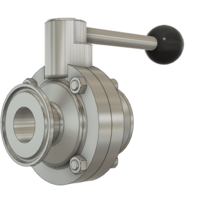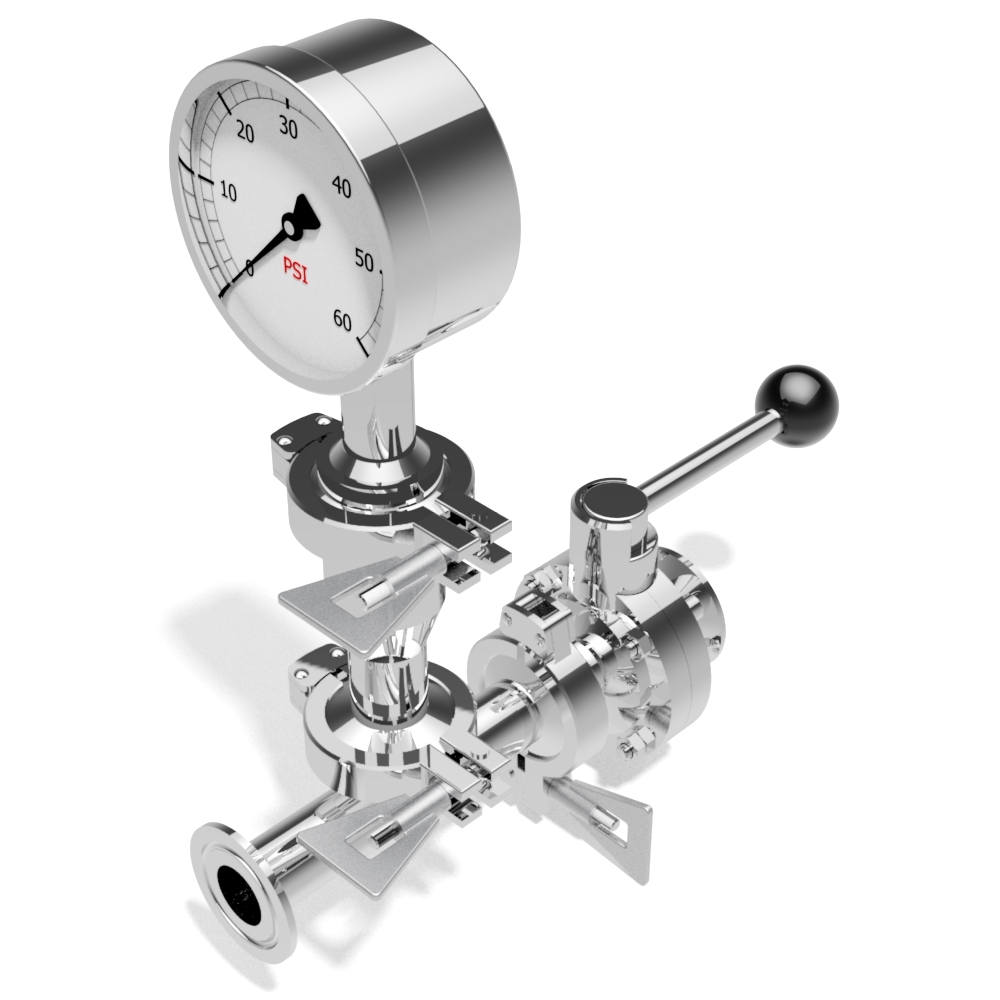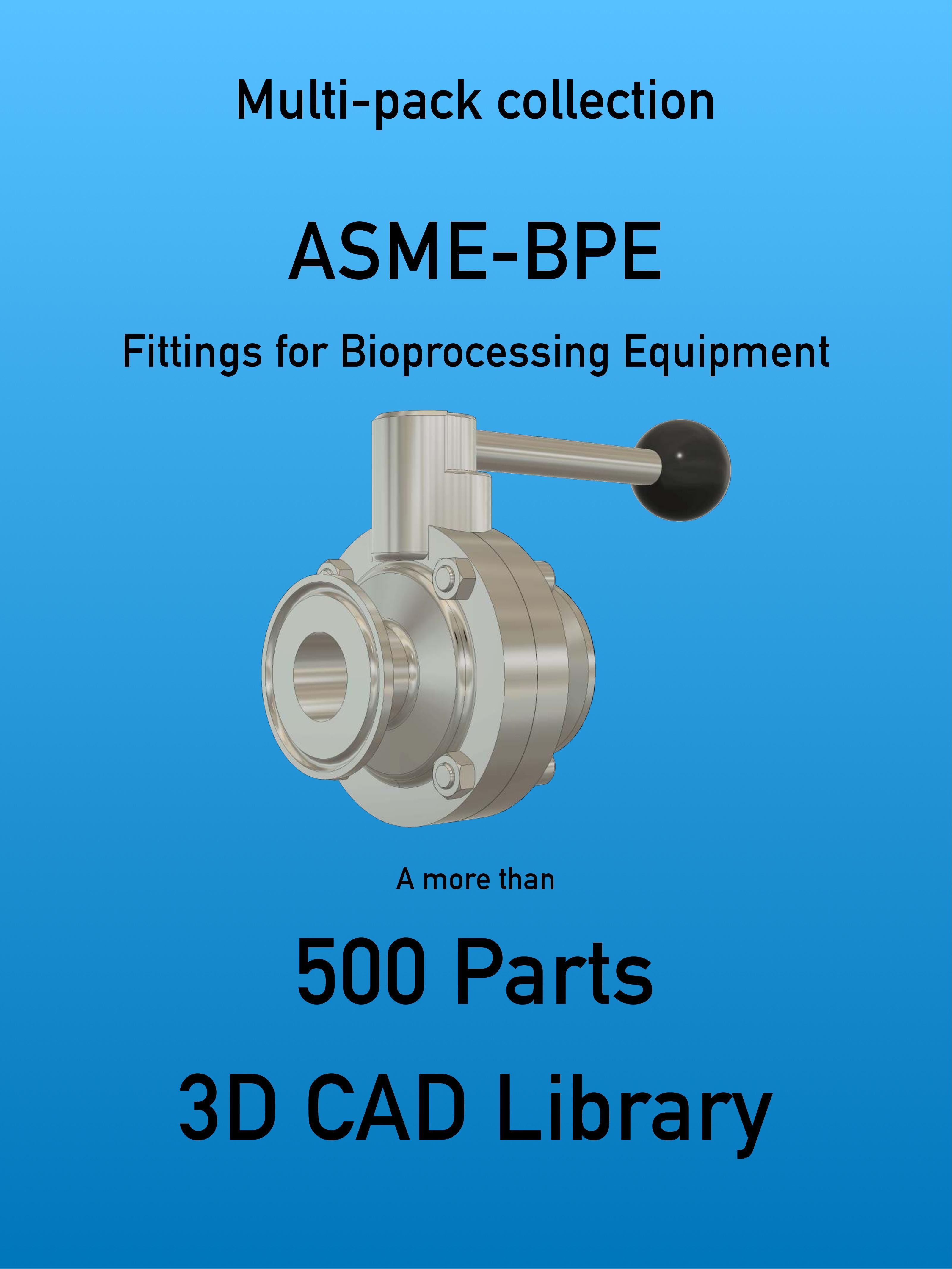Premium Quality 3D CAD Files for Your Engineering Projects
3D CAD Files Collections Hygienic Process Equipment ASME-BPE Biopharma ASME-BPE: more than just a standard
ASME-BPE: more than just a standard

What is the ASME-BPE Standard?
The American Society of Mechanical Engineers Bioprocessing Equipment (ASME BPE) is regarded as an international standard that regulates the equipment designs employed in bioprocessing, pharmaceutical, and industries that require a high level of hygiene.
It often deals with designs, materials, inspections, fabrication, certification as well as testing of equipment.
ASME BPE is essential and a leading standard that stipulates the standards to be followed in the design and fabrication of bioprocessing and pharmaceutical equipment by incorporating the best practices aimed at enhancing the safety and purity of products manufactured.
Through ASME BPE standard, companies can attain production efficiencies, minimize manufacturing costs, lower development, and increasing safety and quality of products while at the same time complying with the set regulations.
SanitaryFittings-CAD.com
ASME-BPE Fitings 3D CAD Files: Download now
Historical background of ASME-BPE
The history of the ASME BPE standard can be traced back to 1997 when the ASME first published the standards for bioprocessing equipment.
Until then, there were no regulatory standards directed towards the requirements and needs for equipment used in the bioprocessing and pharmaceutical industries.
However, by harmonization and scrutinization efforts, the ASME incorporated acceptable methodologies while working together with FDA regulatory requirements provided a set of standards that are vital and integral to the bioprocessing and pharmaceutical industries.
The development of this standard allowed harmonization of various other standards thereby preventing conflicts and omissions between various related standards. Ever since the establishment of this standard, it has been constantly updated through 2002, 2005, 2009, and lastly in 2016 based on the technological advancements in the aforementioned industries.
Overview of the ASME BPE standard
The ASME BPE standard is categorized into 10 sections that address the requirements for various systems and production units. An overview of the ASME BPE standards is described herein.
- General requirements: This part describes a review of laws and standards that various manufacturers should comply with when utilizing pressurized equipment.
- System design: This section outlines clean ability and bio burden control required for various system’s processes, utilities as well as components used.
- Process instrumentation: This section addresses the instrumentation required for flow rate control, temperature control, and pressure instruments, among others.
- Dimensions and tolerances for process equipment: This part outlines topics including the wall thinness of equipment, pressure rating, and hygiene clamp union.
- Metallic materials: This part provides information details of various alloys, outlines different types of metallic materials and to a larger extent gives specific details of ferrite levels and sulfur content requirements.
- Material joining: In this section, various material joining practices are described in detail. These include acceptable discoloration at welded parts.
- Polymeric and non-metallic materials: This section outlines the leachability and compatibility of various polymeric and non-metals.
- Sealing components: This part addresses the requirements for seals, valves, and fittings. It outlines the details regarding static seals such as hygienic unions and O-rings. It also provides requirements for dynamic seals such as diaphragm valves and dual mechanical seals.
- Product contact and surface finishes: This section specifies the required surface finishes for various components of the system. It also gives details regarding passivation and electropolishing.
- Certification: This section provides information regarding how companies may obtain the ASME BPE certification and outlines the requirements that may change over time. As such, for fitting and tubing manufacturers, this section provides a primary distinction in terms of requirements.
SanitaryFittings-CAD.com
ASME-BPE Fitings 3D CAD Files: Download now
Much more than just a standard
In conclusion, the ASME BPE standard has played a critical role in the betterment of the pharmaceutical and bioprocessing industry at large. It, therefore, remains an essential factor in the development of new and improved products. Based on the various processes of operation, various sections of the ASME BPE standard apply. It is therefore important to adhere to the stipulated regulations to ensure the safety and quality of products manufactured through various bioprocessing and pharmaceutical equipment.
ASME-BPE Tube dimensions
|
Size |
Dimensions (mm) |
|
1/2" |
12,7 x 1,65 |
|
3/4" |
19,05 x 1,65 |
|
1" |
25,4 x 1,65 |
|
1 1/2" |
38,1 x 1,65 |
|
2" |
50,8 x 1,65 |
|
2 1/2" |
63,5 x 1,65 |
|
3" |
76,2 x 1,65 |
|
4" |
101,6 x 2,11 |
|
6" |
152,4 x 2,77 |
ASME-BPE fittings codes
The fittings that you can use in an ASME-BPE system have been given a designation code. With this code you can be sure that you have the right part.
As you can see in the table, the tri-clamp parts and also the butterfly valves do not have a part number. However, they are included in this table because they are very often used in combination with ASME-BPE tubing.
|
ASME-BPE Code |
Fitting type |
|
DT-4.1.1.1 |
Elbows 90° - Welding ends |
|
DT-4.1.1.2 |
Elbows 90° - Welding end x Tri clamp |
|
DT-4.1.1.3 |
Elbows 90° - Tri clamps |
|
DT-4.1.1.4 |
Elbows 45° - Welding ends |
|
DT-4.1.1.5 |
Elbows 45° - Welding end x Tri clamp |
|
DT-4.1.1.6 |
Elbows 45° - Tri clamps |
|
DT-4.1.1.7 |
Return bends 180° - Welding ends |
|
DT-4.1.1.8 |
Return bends 180° - Tri clamps |
|
DT-4.1.2.1 |
Straight tees - Welding ends |
|
DT-4.1.2.1 |
Straight crosses - Welding ends |
|
DT-4.1.2.2 |
Short outlet tees - Welding ends x Tri clamp |
|
DT-4.1.2.3 |
Short run outlet tees - Welding ends x Tri clamp |
|
DT-4.1.2.4 |
Straight tees - Tri clamps |
|
DT-4.1.2.4 |
Straight crosses - Tri clamps |
|
DT-4.1.2.5 |
Short outlet tees - Tri clamps |
|
DT-4.1.2.6 |
Reducing tees - Welding ends |
|
DT-4.1.2.7 |
Short outlet reducing tees - Welding ends x Tri clamp |
|
DT-4.1.2.8 |
Reducing tees - Tri clamps |
|
DT-4.1.2.9 |
Short outlet reducing tees - Tri clamps |
|
DT-4.1.2.10 |
Instrument tees - Welding ends x Tri clamp |
|
DT-4.1.2.11 |
Instrument tees - Tri clamps |
|
DT-4.1.3.1 |
Concentric reducers - Welding ends |
|
DT-4.1.3.1 |
Eccentric reducers - Welding ends |
|
DT-4.1.3.2 |
Concentric reducers - Tri clamp x Welding end |
|
DT-4.1.3.2 |
Eccentric reducers - Tri clamp x Welding end |
|
DT-4.1.3.3 |
Concentric reducers - Tri clamps |
|
DT-4.1.3.3 |
Eccentric reducers - Tri clamps |
|
|
Long type Tri clamp ferrule |
|
|
Short type Tri clamp ferrule |
|
|
Tri clamp rings |
|
|
Tri clamp seal rings |
|
|
Manual butterfly valves - Welding ends |
|
|
Manual butterfly valves - Tri clamps |
|
|
Pressure gauges - Bottom connection |
|
|
Pressure gauges - Rear connection |
|
|
Pressure gauges - Left side connection |
|
|
Pressure gauges - Right side connection |
|
|
|
We have made all the 3D CAD files for you!
If you are a process or piping designer, then our 3D CAD collection should not be missing in your toolbox.
It is the most complete 3D CAD library of ASME-BPE fittings that can be found on the internet and contains all parts in all possible diameters.

